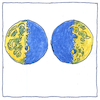Galileo Galilei
astronomy

|
Observational astronomy
Hans Lippershey’s assistant, maybe, discovered that combining a weak convex lens with a strong concave lens made distant objects appear close to the eye. Lippershey and another lens-maker Zacharias Janssen began making telescopes in the fall of 1608. Within a year, Galileo Galilei had made more powerful telescopes and had turned them to the heavens. Thereupon, Galileo, discovering that the moon had mountains that Jupiter had moons that the constellations were crowded with stars that the eye could not see that the Milky Way was composed of stars and that planets had a measurable width, became the first “starry messenger.”
Verifiable
Disbelief and hostility followed Galileo’s assertion that the heavens were not perfect. Surely if Galileo were not mad then his telescope had optical defects that created the illusion of moons. The Grand Duke paid Galileo to make telescopes and had them sent to courts throughout Europe so that others could verify his observations. Several astronomers published confirmations of the existence of the moons of Jupiter within the year.
What one cannot see
Limited by nature, one cannot see what one cannot see how strange plants and animals grew and died in distant and unfamiliar times and places, how distant worlds suffered the ravages of time cratered by unknowable asteroids, how the infinite makes the universe impossibly old, so it’s only common sense, not fear or faith, to meet foolish assertions with scorn.



Galileo Galilei rushed a full description of his findings into print, publishing Sidereus Nuncius (“Starry Message”) in March 1610. Other astronomers were not far behind him, confirming his observations. The Catholic Church was upset with Galileo’s confirmation of Copernican heliocentrism, banning his books for over two hundred years.
See also in The book of science:
Readings in wikipedia: